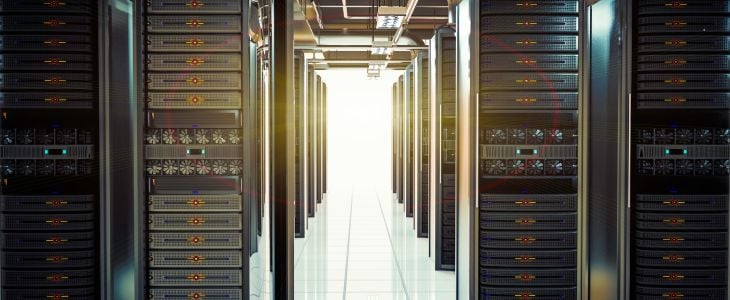A glance at data centers in the Middle East reveals a rapid transformation and growth, meaning the region is increasingly important in the field of global data center operations.
The region’s strategic location paired with significant supportive government policies, and an escalating focus on digital services all combine to ensure an expansion of the future of the data center industry in the area.
In fact, while the global data center market is poised to grow at a CAGR of 7.5% in the next decade (according to Globe Newswire), forecasts for the Middle East data center market project a CAGR of 14.74% (according to Mordor Intelligence).
What exactly is driving this growth and what does the future data center in the Middle East look like? Let's find out.
The current outlook of data centers in the Middle East
By the end of 2023, there were approximately 73 data center colocation facilities in operation in the Middle East, according to a report by JLL. At the same time, a majority of data centers in the Middle East comply with tier 3 and tier 4 standards, a decision for optimized redundancy
The United Arab Emirates lead these figures, followed by Saudi Arabia, Qatar, Oman and Kuwait. These figures could change in the future, as Saudi Arabia prepares the building of 40 new centers in the making.
In fact, a closer look to each territory within the Middle East reveals different levels of maturity in terms of data center development:
- The data center market in Saudi Arabia grows in accordance with this country being the largest economy in the region. Impressive governmental support for data center growth will probably turn Saudi Arabia into the data center hub of the future.
- The UAE has so far led in terms of data center capacity, mainly due to a growing population that’s also digitally savvy, with Dubai positioned as a major international business center
- The data center industry in Qatar saw a major uplift for the 2022 world cup, as new infrastructure and investments were attracted to the region, including the entry of Microsoft and Google as cloud providers. Another contributing factor being that Qatar was the first country in the world to launch commercial 5G in 2020. These developments will likely cascade into further growth and maturity.
- The entrance of Google cloud as a hyper scaler in Kuwait in 2023 marks a major advancement and an increase in interests for international investors looking to join the future of the data center industry in the region.
- With the highest number of subsea cables and a focus on opening up to attract foreign investment, Oman’s data center industry currently presents 7 data centers and will see the development of 5 more in the coming years
- Active governmental support in Bahrain means the region has emerged as an attractive location with lower costs and a stable and safe geopolitical climate.

Investment initiatives in the region range from leading technology companies such as Microsoft, Amazon and Google to Real Estate Developers and government-backed support.
All of them are attracted by the region’s drivers for data center market growth, which include:
- Data sovereignty efforts and norms, which dictate that specific types of data must be located within the country.
- A surge in data and digital services consumption among consumers.
- An increase in migration to cloud platforms for data hosting.
- The growth of use of applications that integrate artificial intelligence.
- A demand for lower latency.
- The Middle East's geographical location as a central hub between Europe, Asia, and Africa.
Trends shaping the data center in Middle East of the future
Increasing presence of hyperscalers
The term Hyperscalers refers to top-level technology enterprises engaged in the construction and management of data centers on a global scale. Examples include Microsoft, Amazon, Oracle or Google. Because of their high level of resources, they tend to build resilient infrastructure with minimal latency.
While the presence of, hyperscale in the Middle East in 2023 is less than 5% of the total global presence, significant investments have been undertaken for the coming years and future data centers in the region.
A new focus on Artificial Intelligence
AI is increasingly being integrated into data center operations to enhance efficiency and streamline various processes. While this is a global trend, it’s expected to also be relevant for data centers in the Middle East in the foreseeable future.
From an improved operational efficiency, to better energy management and security enhancements, the emergence of AI in data centers in the Middle East reflects a strategic move towards optimized technological infrastructure.
The push for Smart cities
Data centers serve as the foundational infrastructure for smart cities, as they offer essential computing resources and storage capacities that are necessary to sustain intelligent applications. Smart grids, advanced transportation systems, and sensor networks are only functional with the right data center to back them up.
With massive projects for smart city developments in the coming years (including Neom, Qiddiya, and King Abdullah Economic City), the Middle East will likely see a growing demand for data centers to match these efforts.
Optimized cybersecurity
The increased focus on security is indeed a significant trend for data centers in the Middle East. While security considerations are crucial to protect the data stored and processed in these facilities, data centers in the Middle East will be placing a strong emphasis on cybersecurity.
This goes from implementing advanced measures to ensuring regulatory compliance, in a comprehensive approach to ensure the reliability and trustworthiness of these critical facilities.

A quest for efficiency
Achieving data center efficiency is and will be a top priority both for economic and environmental reasons. This global trend will also apply to data centers in the Middle East, which also seek ways for optimizing performance, reducing costs, and minimizing environmental impact.
Key strategies for enhancing efficiency include a focus on energy and cooling solutions for data centers. This includes implementing reliable energy-efficient cooling solutions through the incorporation of Thermal Energy Storage (TES) systems as well as systems for waste heat recovery in data centers, which re-use heat emitted by a data center that would otherwise be wasted.
Modular and fully-integrated plants are also aligned with this quest for higher efficiency, as they provide scalability to match a project’s current and future resource needs.
Optimize data center redundancy
Data center redundancy incorporates optimizations with the aim of avoiding downtime during unexpected emergencies, such as power outages or equipment failure. While there are many ways data centers in the Middle East can approach this issue, on-site power generation is proving to be a successful strategy to avoid power disruptions and energy rising costs.
Integration of renewable energy and green data centers
Green data centers stand out as another key development in the future of the data center industry in the Middle East.
From using energy-efficient equipment to incorporating renewable energies to cooling systems, this approach to data centers in the Middle East is set to grant substantial environmental and economical savings.
At ARANER we work at the forefront of state-of-the-art cooling solutions for data centers in the Middle East.
As such, our Al-Ashghal project in Qatar aligns with many of the region’s most advanced projects in terms of sustainability and economic efficiency.
Get in touch with our team to learn more about us and how we can help you.










